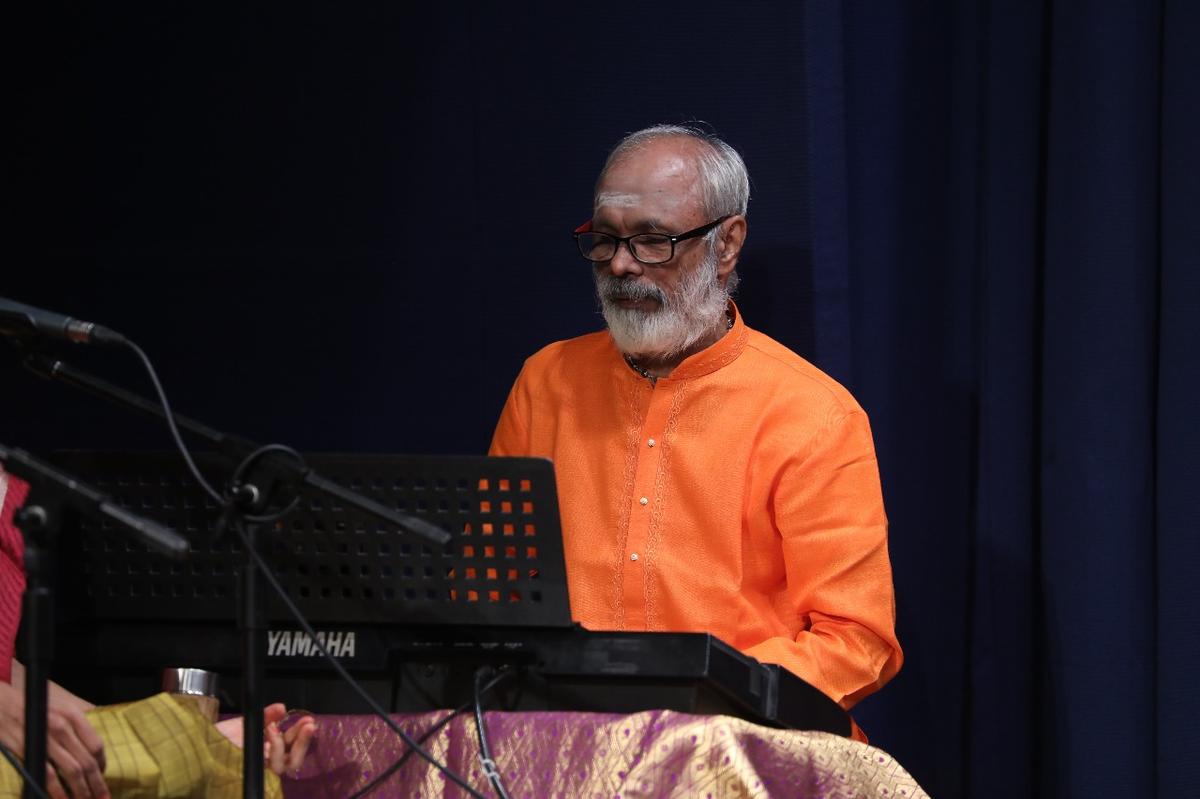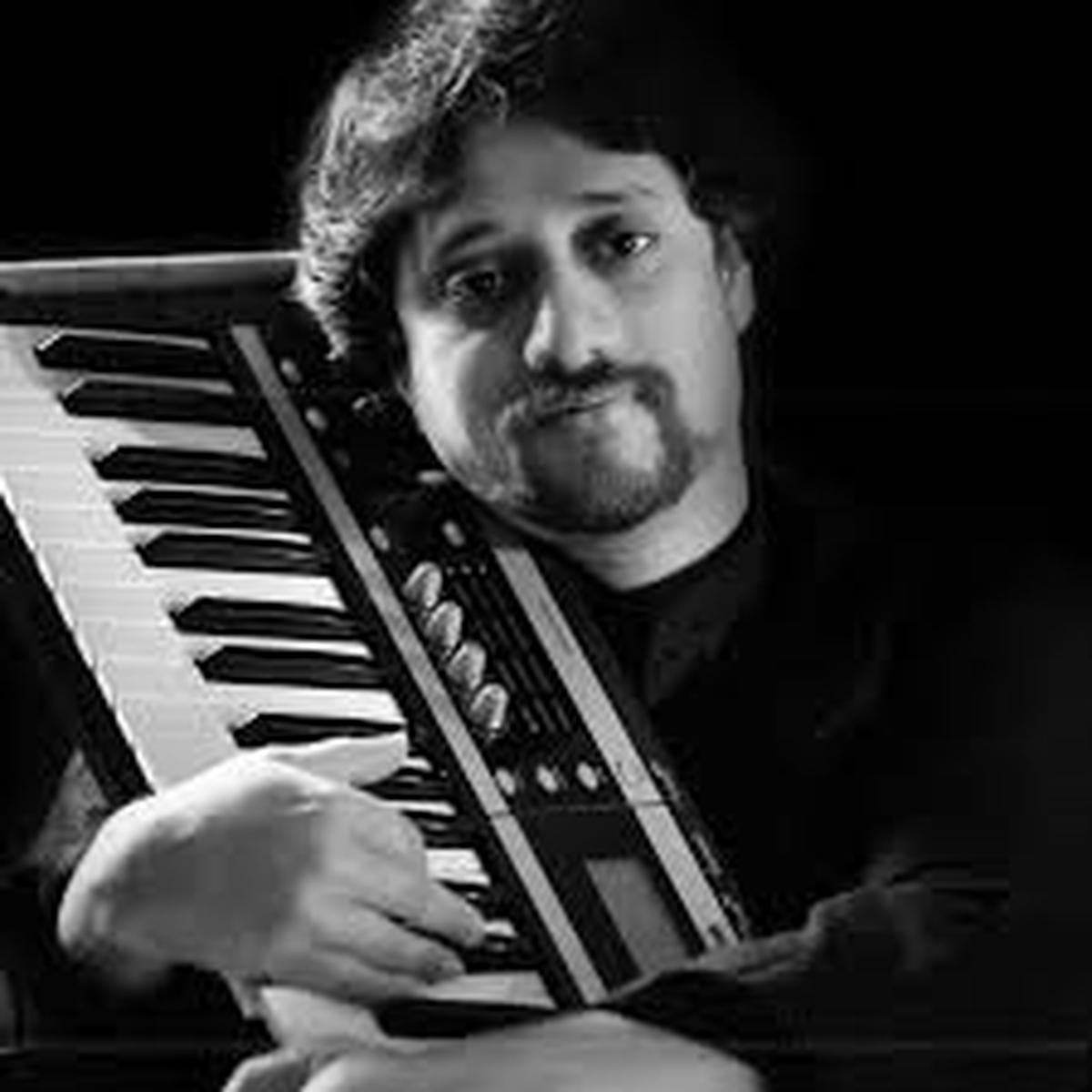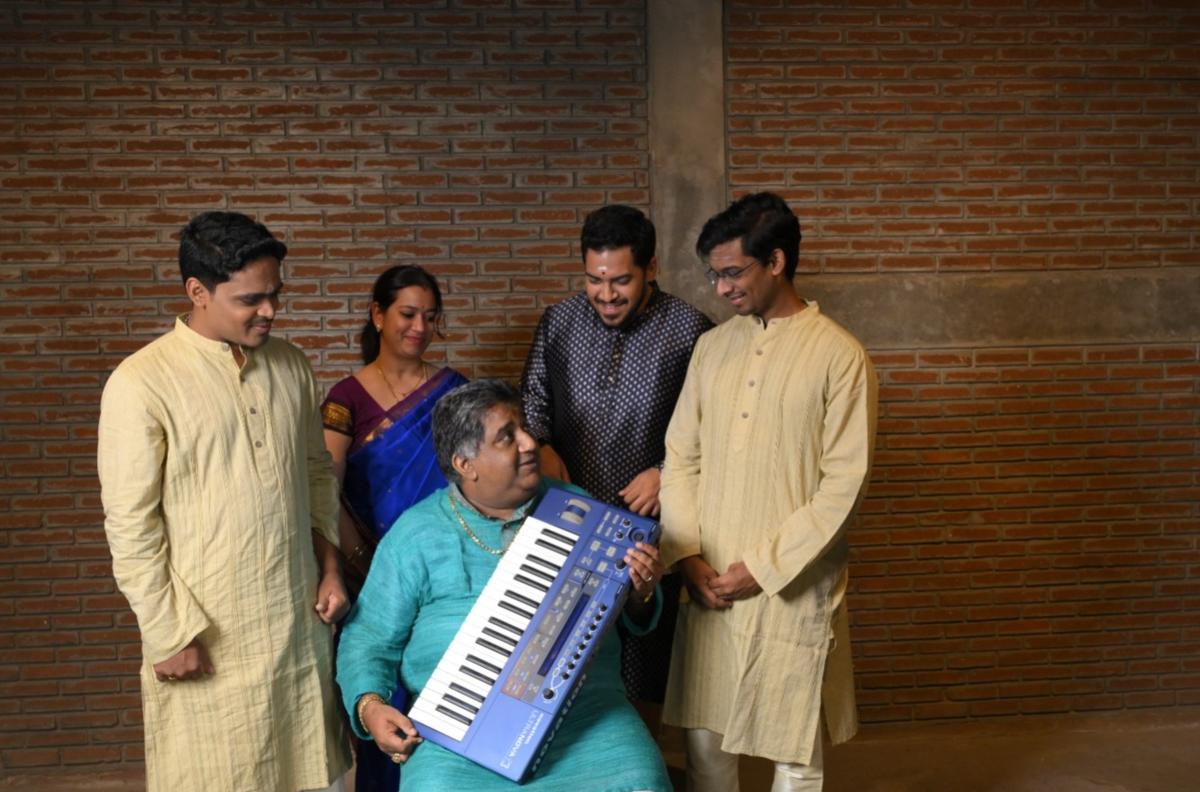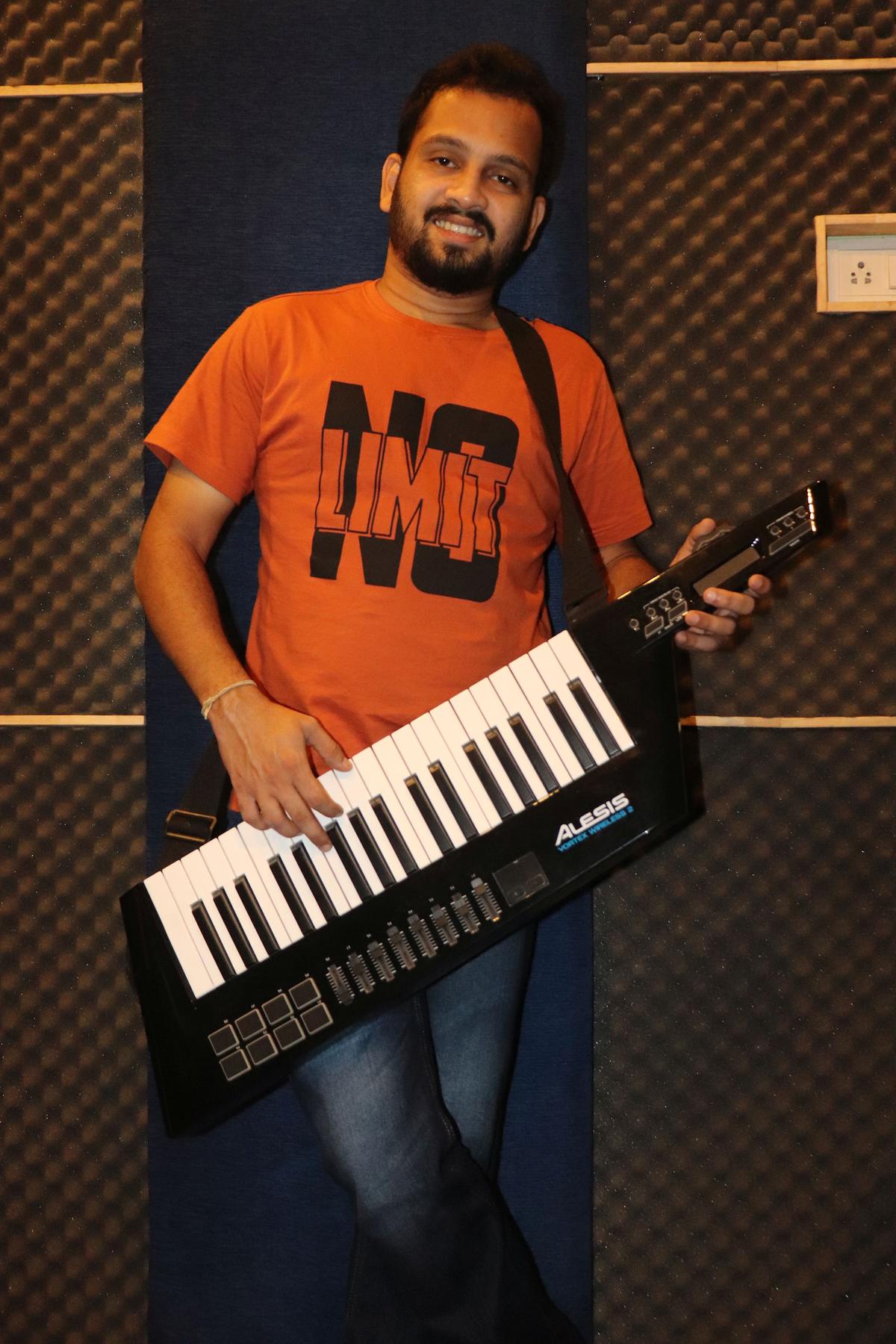Western instruments have long been part of Carnatic music’s landscape. The violin is credited as one of the earliest to be adapted into Carnatic concerts in the early 19th century by Baluswami Dikshitar, the younger brother of the renowned composer Muthuswami Dikshitar. He recognised the violin’s potential as an ideal accompaniment for Carnatic music due to its tonal ability to imitate vocal nuances.
Over time, musicians have seamlessly integrated Western genres into the Carnatic milieu, creating fresh expressions while retaining the music’s roots. V.S. Narasimhan’s Madras String Quartet reimagined Carnatic classics for Western string instruments, merging East and West. Kadri Gopalnath, U. Shrinivas, R. Prasanna, and Anil Srinivasan introduced the saxophone, mandolin, guitar, and the piano, respectively, into the Carnatic fold. Now, the electronic keyboard is also being adapted into the classical world.

P.R. Venkatasubramanian
| Photo Credit:
Special Arrangement
In the mid-1980s, harmonium exponents Palladam Venkataramana Rao and P.R. Venkatasubramanian were among the first to recreate Carnatic nuances on the keyboard. They learned to use the inbuilt synths and settings — such as portamento (essential for Carnatic gamakas, allowing continuity, sliding, and gliding of the swaras) and the pitch bender (a lever enabling smooth note transitions) — from keyboard artistes who played for film music.
Rhythmic fusion
Apart from performing solo keyboard concerts, Venkatasubramanian, also known as ‘Keyboard Subbu’, introduced keyboard as an accompanying instrument in Bharatanatyam recitals. He first used the Roland Promars synthesiser for a dance performance in Salem in 1985. Venkatasubramaniam has also released albums Bhakti Margam and Bharatanatya Margam featuring thekeyboard. He says, “Initially, the keyboard, as a Bharatanatyam dance accompaniment was met with some apprehension. However, dance gurus such as Kanchana Janardhanan and Udupi Laxmi Narayan recognised its versatility and made it part of their presentations. Soon, other gurus followed.”
Recalls flautist Prapancham Balachandran, son-in-law of Venkataramana Rao, “He played the swaras seamlessly by adjusting the technical settings. Venkataramana’s violinist-daughter Brinda Raghunath adds that her father recreated the veena’s tonal richness on the Yamaha synthesiser DX100. He also went on to release albums such as Electronic Organ (Keyboard) and Elara Sri Krishna.

Palladam Venkataramana Rao
| Photo Credit:
Special Arrangement
An evolving journey
Vocalist and flautist Palakkad Sreeram began experimenting with ragas and talas on a Casio MT-31 synthesiser at the age of 13. He later explored the more advanced Casio CZ-101 and eventually mastered its adaptation through MIDI (Musical Instrument Digital Interface), a system that digitally connects instruments to share music data. After completing his post-graduation in music from Calicut University, he moved to Chennai to pursue a career in Carnatic music. However, he faced resistance for championing a Western instrument.
Recalling his lec-dem and concert at The Fine Arts Society, Chembur, in Bombay in 1998, arranged by his guru T.R. Subramanian, Sreeram says, “During the interactive segment, I asked the audience to sing any raga or song and played them with gamakas on my synthesiser. Veteran artistes T.K. Govinda Rao and Bala Mani, who were in the audience, and quiet a few rasikas were amazed. I was accompanied by Sridhar on the mridangam. The next year, I played at the same venue with thavil artiste Valaiyapatti Mallarvannan.
Sreeram, who performs three-in-one concerts — flute, synthesiser and vocal — is a known name in the world of film music too. He has also been part of fusion ensembles of T.V. Gopalakrishnan, Louis Banks, Ranjit Barot and Ghatam Karthick.
According to Sreeram, a B High-grade AIR artiste in keyboard, “Carnatic maestros including U. Shrinivas, Chitravina Ravikiran, A. Kanyakumari, T.V. Gopalakrishnan and M. Balamuralikrishna have mentored and supported young Carnatic keyboardists.”

S. Harikrishnan
| Photo Credit:
Special Arrangement
Sonic blend
Among them is S. Harikrishnan, son of well-known ghatam artiste T.H. Subashchandran, who began to play the keyboard at the age of 13 and became part of his father’s ensemble ‘Shankara’. He also accompanied exponents Ravikiran and Gopalakrishnan in concerts. After his initial training under musician-composer Ramesh Vinayagam to play western notes on the keyboard, he began to play Carnatic music on the Korg Triton keyboard by himself.
Inspired by Venkataramana Rao, Harikrishnan, released his first album, Prakruthi, based on Carnatic kritis, featuring his father. Three years ago, he released the album Swararpana, which had V. Selvaganesh on the kanjira and V. Umashankar on the ghatam accompanying him. Harikrishnan also launched the ensemble Swarhythm to turn the spotlight on the keyboard. “The idea was to highlight the instrument’s Carnatic dimension and give it an international recognition. Besides my father, I drew inspiration from my uncle Vikku Vinayakram, who put the ghatam on the global stage,” says Harikrishnan, who is currently training under senior violinist Delhi Sunderarajan.

K. Sathyanarayanan.
| Photo Credit:
Special Arrangement
Another young musician, who honed his skills under Carnatic maestros is K. Sathyanarayanan, popularly known as ‘Keyboard Sathya’. Grandson of vocalist Embar Sadagopan and nephew of violinist Embar Kannan, he performed live on Doordarshan when he was just eight.
“Choosing to pursue the keyboard has been fraught with challenges,” says Sathya. An Indian musician based in the U.S. saw his performance online and wanted to gift him a Korg Trinity Pro keyboard with advanced features. “Considering the high cost of the instrument, it came as a blessing,” shares Sathya, who as a 10-year-old explored the keyboard’s capabilities, including monophony (playing one note at a time for melodic clarity) and legato (smooth transitions between notes). “I developed my signature jazz guitar tone and a separate tone titled ‘Shrinivas’ in memory of my guru U. Shrinivas, which I have been playing at concerts.”
Sathya enhanced the instrument’s scope by learning to use the portamento setting from Palladam Venkataramana Rao. He has researched gamakas mentioned in the Sangita Sampradaya Pradarshini and their interpretation on the keyboard. The turning point in his journey came when he received an A-grade certification from All India Radio (AIR) in 2010 and the Kalaimamani title in 2018. “The recognition opened new avenues for me. Although I performed in temples and chamber concerts, getting slots in sabhas remained a challenge, “ says Sathya, who owns over 20 keyboards.

Palakkad Sreeram (seated), Srivaralaxmi Maya, Vigneswar V G and Arjun and Narayanan
| Photo Credit:
V. Shiva Raj Vedhan
“When the keyboard was little known, I had to give demonstrations to sabha organisers to showcase it during the Margazhi music season,” says AIR-graded keyboardist Srivaralaxmi Maya. She belongs to the musical lineage of vidwan Kothavasal Venkatrama Iyer and Kumbakonam Brothers — S. Shankaran and S. Vishwanathan. She received her initial training from her grandfather and her mother, vocalist V. Nandhini. “They made me practise daily for long hours, as intricate gamakas are challenging to play on a Western instrument, especially in ragas such as Varali, Sankarabharanam, Kiravani and Arabhi. Over time, I perfected these on my Korg TR-61.”
‘Keyboard Brothers’ Arjun and Narayanan were introduced to Korg by Sathya. “We soon learnt its technicalities,” say the brothers, who, at the age of seven, were initiated into Carnatic keyboard classes of Korattur Sahasranamam. “We are grateful to have met and been mentored by the inimitable Mandolin Shrinivas, who, impressed by our Shanmukhapriya rendition agreed to guide us. Though we wished to learn the mandolin, he advised us to continue with the keyboard.”
Narayanan developed a tone close to the mandolin. “Sir was pleased with our first basic tone and asked us to use it in concerts,” he shares. The brothers honed the gamaka-playing technique under Chitravina N. Ravikiran. Arjun recalls how once during a lecture-demonstration, “when our guru was asked if he would perform on an electronic chitravina, he urged the audience to listen to our keyboard rendition”. Musician and educator Anil Srinivasan helped them gain an understanding of the western nuances on the keyboard.
Legendary learnings
Vigneswar V G, a B High-grade AIR artiste, feels blessed to have trained for 20 years under the legendary T.V. Gopalakrishnan. He would sing the sahityam and swaras, which I reproduced,” he recollects. On his guru’s advice, Vigneswar upgraded to a Roland GW8 keyboard and trained in the gayaki style. To promote the instrument, his guru had him accompany him for 25 concerts. Speaking about his first international performance in Malaysia in 2017 — where he played alongside his guru, Vigneswar says, “The audience was amazed by the instrument’s broad musical range.” Vigneswar has performed for Ghatam Karthick’s Heartbeat Ensemble, Sikkil Gurucharan’s Janal Oram, and Subashree Thanikachalam’s QFR.
Apart from these musicians, senior keyboard artistes such as M.S. Martin, who started ‘Mellifluous Melodies on Keyboard’, and U.S.-based N.M. Muralikrishnan, a vainika and director of the Spring Nectar Academy, have nurtured several students. They have presided over numerous arangetrams and are known for leading some of the largest Carnatic keyboard ensemble concerts.
Over the past few decades, the introduction of Western instruments in Carnatic music shows the classical world’s growing acceptance of tradition-inspired innovations. This has created new opportunities for passionate young learners and artistes.
The evolution of keytar

Keytar artiste A.S. Ram.
| Photo Credit:
Special Arrangement
In 2009, A.S. Ram, Kadri Gopalanath’s disciple and a sound engineer and music programmer, explored the enhanced features of the handheld keytar, a keyboard blended with keys and guitar features. Ram, who has performed Carnatic solo keytar concerts and collaborated with renowned artistes, says, “With my technical background, I could quickly develop a tone, a combination of veena and mandolin—Mandolina.” He has performed his Carnatic compositions on the keytar in his fusion band, The Pulse. Film music directors Manikanth Kadri and Joshua Sridhar have used Ram’s keytar tracks in their compositions.




















